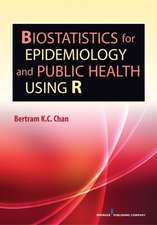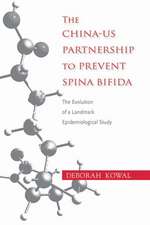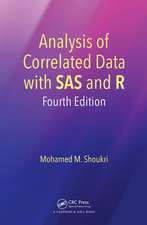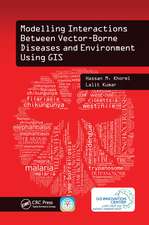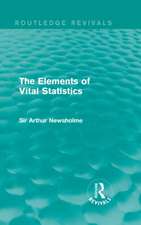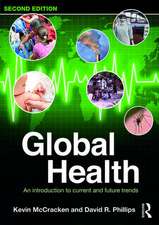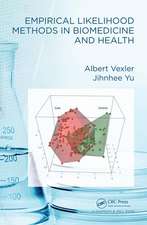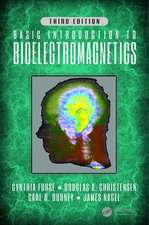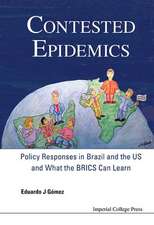Statistics in the Health Sciences: Theory, Applications, and Computing
Autor Albert Vexler, Alan Hutsonen Limba Engleză Hardback – 7 feb 2018
"It is always a pleasure to come across a new book that covers nearly all facets of a branch of science one thought was so broad, so diverse, and so dynamic that no single book could possibly hope to capture all of the fundamentals as well as directions of the field. The topics within the book’s purview—fundamentals of measure-theoretic probability; parametric and non-parametric statistical inference; central limit theorems; basics of martingale theory; Monte Carlo methods; sequential analysis; sequential change-point detection—are all covered with inspiring clarity and precision. The authors are also very thorough and avail themselves of the most recent scholarship. They provide a detailed account of the state of the art, and bring together results that were previously scattered across disparate disciplines. This makes the book more than just a textbook: it is a panoramic companion to the field of Biostatistics. The book is self-contained, and the concise but careful exposition of material makes it accessible to a wide audience. This is appealing to graduate students interested in getting into the field, and also to professors looking to design a course on the subject." — Aleksey S. Polunchenko, Department of Mathematical Sciences, State University of New York at Binghamton
This book should be appropriate for use both as a text and as a reference. This book delivers a "ready-to-go" well-structured product to be employed in developing advanced courses. In this book the readers can find classical and new theoretical methods, open problems and new procedures.
The book presents biostatistical results that are novel to the current set of books on the market and results that are even new with respect to the modern scientific literature. Several of these results can be found only in this book.
| Toate formatele și edițiile | Preț | Express |
|---|---|---|
| Paperback (1) | 314.22 lei 6-8 săpt. | |
| CRC Press – 29 aug 2022 | 314.22 lei 6-8 săpt. | |
| Hardback (1) | 685.22 lei 6-8 săpt. | |
| CRC Press – 7 feb 2018 | 685.22 lei 6-8 săpt. |
Preț: 685.22 lei
Preț vechi: 917.03 lei
-25% Nou
Puncte Express: 1028
Preț estimativ în valută:
131.13€ • 142.39$ • 110.15£
131.13€ • 142.39$ • 110.15£
Carte tipărită la comandă
Livrare economică 22 aprilie-06 mai
Preluare comenzi: 021 569.72.76
Specificații
ISBN-13: 9781138196896
ISBN-10: 1138196894
Pagini: 416
Ilustrații: 29 Line drawings, black and white; 1 Halftones, black and white; 10 Tables, black and white; 30 Illustrations, black and white
Dimensiuni: 156 x 234 x 26 mm
Greutate: 0.7 kg
Ediția:1
Editura: CRC Press
Colecția Chapman and Hall/CRC
ISBN-10: 1138196894
Pagini: 416
Ilustrații: 29 Line drawings, black and white; 1 Halftones, black and white; 10 Tables, black and white; 30 Illustrations, black and white
Dimensiuni: 156 x 234 x 26 mm
Greutate: 0.7 kg
Ediția:1
Editura: CRC Press
Colecția Chapman and Hall/CRC
Cuprins
Prelude: Preliminary Tools and Foundations
Characteristic Function Based Inference
Likelihood Tenet
Martingale Type Statistics and Their Applications
Bayes Factor
A Brief Review of Sequential Methods
A Brief Review of Receiver Operating Characteristic Curve Analyses
The Ville and Wald Inequality: Extensions and Applications
Brief Comments on Confidence Intervals and P-Values
Empirical Likelihood
Jackknife and Bootstrap Methods
Examples of Homework Questions
Examples of Exams
Examples of Courses Projects
Characteristic Function Based Inference
Likelihood Tenet
Martingale Type Statistics and Their Applications
Bayes Factor
A Brief Review of Sequential Methods
A Brief Review of Receiver Operating Characteristic Curve Analyses
The Ville and Wald Inequality: Extensions and Applications
Brief Comments on Confidence Intervals and P-Values
Empirical Likelihood
Jackknife and Bootstrap Methods
Examples of Homework Questions
Examples of Exams
Examples of Courses Projects
Recenzii
"This very informative book introduces classical and novel statistical methods that can be used by theoretical and applied biostatisticians to develop efficient solutions for real-world problems encountered in clinical trials and epidemiological studies. The authors provide a detailed discussion of methodological and applied issues in parametric, semi-parametric and nonparametric approaches, including computationally extensive data-driven techniques, such as empirical likelihood, sequential procedures, and bootstrap methods. Many of these techniques are implemented using popular software such as R and SAS. "
—Vlad Dragalin, Vice President and Scientific Fellow, Quantitative Sciences, Johnson and Johnson
"It is always a pleasure to come across a new book that covers nearly all facets of a branch of science one thought was so broad, so diverse, and so dynamic that no single book could possibly hope to capture all of the fundamentals as well as directions of the field. Biostatistics is just such a branch of science and Statistics in the Health Sciences: Theory, Applications, and Computing is just such a book. Written by "lions" of the field, the book is an excellent piece of work that establishes an important bridge between Biostatistics and its numerous interfaces. The topics within the book’s purview—fundamentals of measure-theoretic probability; parametric and non-parametric statistical inference; central limit theorems; basics of martingale theory; Monte Carlo methods; sequential analysis; sequential change-point detection—are all covered with inspiring clarity and precision. The authors are also very thorough and avail themselves of the most recent scholarship. They provide a detailed account of the state of the art, and bring together results that were previously scattered across disparate disciplines. This makes the book more than just a textbook: it is a panoramic companion to the field of Biostatistics. The book is self-contained, and the concise but careful exposition of material makes it accessible to a wide audience. The book also offers numerous problems and computer projects, including data processing exercises, which range in complexity and degree of sophistication from introductory to fairly advanced. This is appealing to graduate students interested in getting into the field, and also to professors looking to design a course on the subject. To sum up, the book is a valuable addition to the literature, and certainly deserves a spot in the library. Perhaps the best way to express one’s gratitude to the authors would be to read the book."
—Aleksey S. Polunchenko, Ph.D., Department of Mathematical Sciences, State University of New York at Binghamton
—Vlad Dragalin, Vice President and Scientific Fellow, Quantitative Sciences, Johnson and Johnson
"It is always a pleasure to come across a new book that covers nearly all facets of a branch of science one thought was so broad, so diverse, and so dynamic that no single book could possibly hope to capture all of the fundamentals as well as directions of the field. Biostatistics is just such a branch of science and Statistics in the Health Sciences: Theory, Applications, and Computing is just such a book. Written by "lions" of the field, the book is an excellent piece of work that establishes an important bridge between Biostatistics and its numerous interfaces. The topics within the book’s purview—fundamentals of measure-theoretic probability; parametric and non-parametric statistical inference; central limit theorems; basics of martingale theory; Monte Carlo methods; sequential analysis; sequential change-point detection—are all covered with inspiring clarity and precision. The authors are also very thorough and avail themselves of the most recent scholarship. They provide a detailed account of the state of the art, and bring together results that were previously scattered across disparate disciplines. This makes the book more than just a textbook: it is a panoramic companion to the field of Biostatistics. The book is self-contained, and the concise but careful exposition of material makes it accessible to a wide audience. The book also offers numerous problems and computer projects, including data processing exercises, which range in complexity and degree of sophistication from introductory to fairly advanced. This is appealing to graduate students interested in getting into the field, and also to professors looking to design a course on the subject. To sum up, the book is a valuable addition to the literature, and certainly deserves a spot in the library. Perhaps the best way to express one’s gratitude to the authors would be to read the book."
—Aleksey S. Polunchenko, Ph.D., Department of Mathematical Sciences, State University of New York at Binghamton
Descriere
This book should be appropriate for use both as a text and as a reference. This book delivers a "ready-to-go" well-structured product to be employed in developing advanced courses. In this book the readers can find classical and new theoretical methods, open problems and new procedures.
Notă biografică
Albert Vexler is a tenured professor in the Department of Biostatistics at the State University of New York (SUNY) at Buffalo. Dr. Vexler is the associate editor of Biometrics and BMC Medical Research Methodology. He is the author and coauthor of various publications that contribute to the theoretical and applied aspects of statistics in medical research. Many of his papers and statistical software developments have appeared in statistical and biostatistical journals that have top-rated impact factors and are historically recognized as leading scientific journals. Dr. Vexler was awarded a National Institutes of Health grant to develop novel nonparametric data analysis and statistical methodology. His research interests include receiver operating characteristic curve analysis, measurement error, optimal designs, regression models, censored data, change point problems, sequential analysis, statistical epidemiology, Bayesian decision-making mechanisms, asymptotic methods of statistics, forecasting, sampling, optimal testing, nonparametric tests, empirical likelihoods, renewal theory, Tauberian theorems, time series, categorical analysis, multivariate analysis, multivariate testing of complex hypotheses, factor and principal component analysis, statistical biomarker evaluations, and best combinations of biomarkers.
Alan D. Hutson is the chair of biostatistics and bioinformatics at Roswell Park Cancer Institute. He is also the biostatistical, epidemiological, and research design director for SUNY’s National Institutes of Health–funded Clinical and Translational Research Award. Dr. Hutson is a fellow of the American Statistical Association, the associate editor of Communications in Statistics and the Sri Lankan Journal of Applied Statistics, and a New York State NYSTAR Distinguished Professor. He has written more than 200 peer-reviewed publications. Dr. Hutson’s methodological work focuses on nonparametric methods for biostatistical applications as they pertain to statistical functionals. He also has several years of experience in the design and analysis of clinical trials.
Alan D. Hutson is the chair of biostatistics and bioinformatics at Roswell Park Cancer Institute. He is also the biostatistical, epidemiological, and research design director for SUNY’s National Institutes of Health–funded Clinical and Translational Research Award. Dr. Hutson is a fellow of the American Statistical Association, the associate editor of Communications in Statistics and the Sri Lankan Journal of Applied Statistics, and a New York State NYSTAR Distinguished Professor. He has written more than 200 peer-reviewed publications. Dr. Hutson’s methodological work focuses on nonparametric methods for biostatistical applications as they pertain to statistical functionals. He also has several years of experience in the design and analysis of clinical trials.



